Integrating Chhattisgarh with Gujarat is the topic for the students living in these two states.
CBSE has introduced subject enrichment project from this year
As you know, It is mandatory for all CBSE school students from class 1 to 10 to take up at least one project in each subject.
The purpose of introducing Art Integrated/ subject enrichment Project is “learning the concepts across subjects.”
While doing the project at least one project by the students from 1 to 10 have to be integrated by any art form of the paired state as
defined under “Ek Bharat Shreshtha Bharat Programme”.
Therefore, the Art – integration Project by the students of Chhattisgarh school will be based on the art form of Gujarat.
Moreover, this will help the students living in Chhattisgarh to know about the rich culture and tradition of Gujarat.
Project on Integrating Chhattisgarh with Gujarat under Ek Bharat Shreshtha Bharat

CBSE PROJECT ON INTEGRATING CHHATTISGARH WITH GUJARAT
Things to be kept in mind while doing this project:
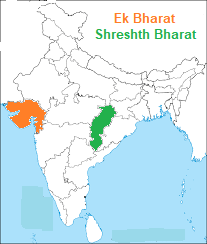
Chhattisgarh and Gujarat
- Use A-4 size file paper (one side ruled) / Chart paper.
- For headings and subheadings use sketch pen.
- Project must be handwritten (use blue/black ink only)
- Design the cover page which should reflect the topic. (use your creativity)
- Mention the Topic of the project, Name, class & section and roll No. on the cover page in bold letters.
- Project can be in your writing/ on a chart paper/ PPT/ greeting card/ handbook etc.
- Avoid using plastic covers and use ecofriendly materials.
- Use drawings, charts, pictures, newspaper cuttings to make your project look colorful, attractive, useful and presentable.
Project on Integrating Chhattisgarh with Gujarat
http://https://www.youtube.com/watch?v=BwU2J8Fuy9k
COVER PAGE
First page will be your cover page. Mention the topic clearly as
“Project on Integrating Chhattisgarh with Gujarat under Ek Bharat Shreshtha Bharat”
AIM OF THE PROJECT (on Integrating Chhattisgarh with Gujarat)
Mention the aim of the project as
“The aim of the project is to understand the Geographical Location, History of Chhattisgarh and Tamil Nadu, Climate, culture, people,
Geography, Dance, Dress, Heritage sites and famous places to visit in Chhattisgarh and Gujarat.’
Draw/ paste or shade the map of Chhattisgarh and Gujarat in the map of India to cover the blank space of your page.
Geographical location of Chhattisgarh
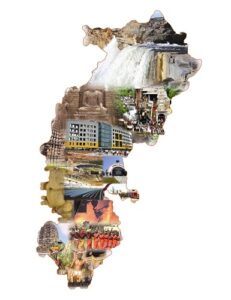
Map of Chhattisgarh
Chhattisgarh is located in east-central India.
It lies between 17° 46′ N to 24° 5′ N Latitude to 80° 15′ E to 84°20′ East Longitude.
It is a land locked state.
Seven states touches the borders of Chhattisgarh.
They are Uttar Pradesh and Jharkhand to the north and northeast, Orissa to the east, Telangana
(formerly part of Andhra Pradesh) to the south,
and Maharashtra and Madhya Pradesh to the west.
It is the ninth largest state of India with Raipur as its capital.
Geographical location of Gujarat (Project on Integrating Chhattisgarh with Gujarat)

Location of Gujarat in India
Gujarat is located on the western coast of India.
It lies between 20° 01′ N to 24° 07′ N Latitude to 68° 04′ E to 74°04′ East Longitude.
It is bounded by Arabian sea on the west.
The state of Rajasthan lies to its North, Madhya Pradesh in the east and Maharashtra in the south.
It also shares an International boundary with Pakistan to its north.
Gujarat is the fifth largest state of India in terms of size with Gandhinagar as its capital.
It has the longest coastline of 1596 km. in India.
Project on Integrating Chhattisgarh with Gujarat
History of Chhattisgarh
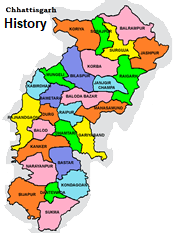
History of Chhattisgarh
The state of Madhya Pradesh was divided to form Chhattisgarh on 1st November 2000.
It was the long demand of the people right from the day of India’s Independence.
During ancient times this region was known as Dakshin-Kaushal which also finds mention in Ramayana and Mahabharata.
Between the 6th and 12th centuries Sarabhpurias, Panduavanshi, Somvanshi, Kalchuri and Nagvanshi rulers dominated this region.
Kalchuris ruled in Chhattisgarh from 980 to 1791 AD.
The name “Chhattisgarh” became popular during the time of the Maratha Empire.
It was first used in an official document in 1795.
The most popular theory claims that Chhattisgarh takes its name from the 36 ancient forts.
Thereafter, in 1904 Sambalpur was transferred to Odisha.
It is said that estates of Sarguja was also transferred from Bengal to Chhattisgarh.
History of Gujarat

History of Gujarat
Gujarat is derived from the Sanskrit word Gurjaradesa which means “The Land of
Gurjaras (Gujjars).
Gujjars ruled in the 8th and 9th centuries.
The state of Gujarat was created on linguistic ground on 1st May 1960.
A political movement known as Mahagujarat aandolan demanded the new state of
Gujarat.
The human settlement in Gujarat is linked with the Indus valley civilization.
Lothal, Rangpur, Rozdi etc. have been found in the kathiawad region.
Gujarat was under Mauryan dynasty (250BCE), followed by Shakas.
During 4th and late 5th century Gujarat was under the rule of Gupta empire.
By the end of 16th century Gujarat was ruled by Mughals.
Gujarat came under the administration of British East India Company in 1818.
Project on Integrating Chhattisgarh with Gujarat
Climate of Chhattisgarh
The climate of Chhattisgarh is tropical.
As the Tropic of Cancer passes through this state.
Direct rays of sun falls making the summers extremely hot.
Summer temperatures in Chhattisgarh can reach 45 °C to 47°C..
The monsoon season is from June to October.
Chhattisgarh receives an average of 1,300 mm of rain.
Winters in Chhattisgarh are mild and pleasant with low temperatures and less humidity.
However, the Northern parts of Chhattisgarh (Mainpat and Ambikapur) have extremely cold winters .
The temperature sometimes is around 2 to 4 degree Celsius.
Climate of Gujarat:
Gujarat has a huge variation in the climatic condition.
The places near the sea coasts are hot and humid.
The interior parts of Gujarat have extreme type of climate.
Moreover, In the Interior parts of Gujarat summers are extremely hot and dry and winters cold.
The day temperature during Summer is as high as 46°C while it is around 34°C at night.
Average temperature during winter day is 29°C while at night around 12°C.
Most of Gujarat receives less rainfall.
Southern parts of Gujarat and hilly regions receive very heavy rainfall which leads to flood.
Project on Integrating Chhattisgarh with Gujarat
Famous Historical Places in Chhattisgarh:
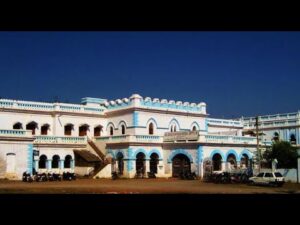
Bastar palace, Chhattisgarh
Chhattisgarh has a rich culture, Heritage and very attractive natural diversity.
It is known for its waterfalls, caves, forests, monuments, temples, wildlife and Buddhist sites.
Chhattisgarh is the most perfect place for you.
This state which is relatively new has a number of historical places that will engage and
enlighten the history lovers.
Top historical places in Chhattisgarh:
Bastar Palace:
The famous Bastar Palace is a palace which was constructed when the Kings of Bastar
moved their capital to Jagdalpur.
The palace has intriguing wall cravings on the walls that adds to its beauty.
Kanker Palace:
Another important historical place in Chhattisgarh is the Kanker Palace.
It was initially constructed in the 20th century and was originally known as Randhanivas Bagicha.
This magnificently elegant palace showcases the influence of colonial architecture.
Bhoramdeo Temple:
The Bhoramdeo Temple was built between the 7th to 11th centuries.
The beauty of this temple will mesmerize you.
It is located in Kawardha.
Often referred to as Khajuraho of Chhattisgarh.
The temple has decorations of religious sculptures.
Kawardha Palace:
Today Kawardha palace is the heritage hotel of Chhattisgarh.
One can see the palace on Maikal hills.
The palace is made from stones and marbles.
It depicts a magnificent example of the culture of the place.
Lush green surroundings and the beauty of the garden in the palace will make you feel closer to the natural environment.
Kotumsar Caves:
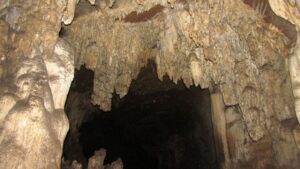
Kotumsar caves and Kailash gufa in Chhattisgarh
The Kotumsar caves and Kailash gufa are one of the major historical places in Chhattisgarh.
These caves are 40 km away from Jagdalpur.
It is one of the longest caves in the world.
Although these caves are not accessible beyond 2 km.
The restriction is largely because of its depth and lack of oxygen inside the caves.
One of the major features of these caves are it produces musical sounds when
you strike the hollow walls of the caves with hands.
Moreover, during winter, you can also see stalactite & stalagmites hanging inside the caves.
There are many more temples, palaces and other attractive sites to visit.
For example, the Devrani-jethani temple, Mahamaya temple, Lakshman temple, Historical site at Sirpur, one of the widest waterfalls in the world etc.
Famous Historical Places in Gujarat:
Gujarat has a long history of 4500 years.
The state has many beautiful historical and architecturally significant sites.
From the remains of Indus valley civilization to stepwell and palaces and glorious Dwarka and Somnath temples.
Rani ki Vav:
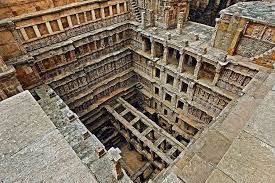
Rani ki Vav, Gujarat (Stepwell)
A UNESCO World Heritage site which exists from the 11th century.
People locally call it as “Queen’s stepwell.”
The length and Depth of this stepwell is 64m X 27m respectively.
The steps and the side walls have richly carved images of various Gods, Goddesses and
Apsaras .
Laxmi vilas palace:
Laxmi vilas palace was the private residence of Maharaja Sayajirao Gaekwad.
The palace is located at Vadodarra in 700 acres of land.
Even today this palace is the home to the royal family of Vadodara Gaekwads.
Dholavira:
At Dholavira, you can see one of the oldest and most remarkable excavations of the Indus valley civilization.
It was one of the most developed civilizations roughly around 4500 years ago.
This historical place in Gujarat is worth seeing unlike any other scenic beauty or modern day attractions.
Sabarmati Ashram:

Gandhiji’s Sabarmati Ashram, Ahmedabad (Gujarat)
The very famous Sabarmati ashram is located on the bank of Sabarmati river.
This ashram has witnessed many important historical events, including India’s
freedom struggle.
Mahatma Gandhi managed the course of the Indian Independence movement
from here.
One can witness the life of the “Father of Nation” here.
It is located in Ahmedabad.
Adalaj stepwell:
One of the greatest masterpieces of Indian architecture.
This stepwell has five storeys.
It exists from15th century.
An example of Islamic architecture and the carvings of Hindu deities on the pillars and walls, is worth seeing.
Project on Integrating Chhattisgarh with Gujarat
Festivals of Chhattisgarh:
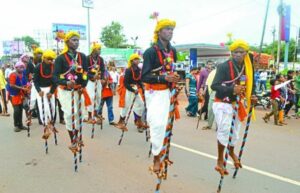
Hareli festival celebration in Chhattisgarh
Chhattisgarh is the land of tribal festivals.
The festival celebrations are generally have dance, music, and holiness.
Above all it is full of utter enthusiasm and reflects ancient traditional values.
The most common tribes found in the state of Chhattisgarh are Miriam, Baiga,
Kamars, Gonds, Bhumja, Kawars etc.
On one hand tribal families like the Gonds have exchanged cultural practices with
the local Hindus while
On the other hand the orthodox tribes like the Baigas and the Kamars have
maintained their originality till date.
The tribal people of the state are very much attached to the nature.
They feel that the forests, hills and their very existence and our deeds are visible to the almighty.
Therefore they try to appease, follow and worship a wide range of Gods and Goddess.
While celebrating the festivals they also practice various forms of rituals and sacrifices.
They consider every step taken by them is according to the wish of God.
One can easily divide tribal festivals into two groups namely domestic (family) affairs and community affairs.
Domestic affairs include marriage, death or birth of an infant where all family members gather and enjoy together.
In community celebrations, people of the entire community gather together and enjoy events like rich harvest and religious festivals.
Some of the festivals are Hareli, Teeja, Goncha, Mela etc.
One of the most important festivals of Chhattisgarh is the Bastar Dussehra.
Bastar Dussehra reflects local myths, religious beliefs and the customs of the tribal.
Festivals of Gujarat:
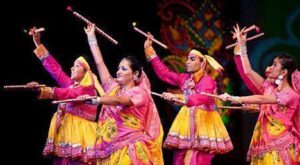
Dandia, Garba and Navratri celebration in Gujarat
India is a very cultural and diverse country, so are the festivals होली और होलिका दहन मनाने के पीछे वैज्ञानिक कारण.
It is one of the largest countries where numerous festivals take place.
These refreshing festivals occur at regular intervals and help in breaking the
monotony of life.
Furthermore, they give you the chance to celebrate the little and big things in
life.
Gujarat is the land of festivals.
It is popular throughout India as well as the world for its spirit of festivity.
Apart from the festival celebrated in the whole nation, there are a host of other festivals distinctively related to the state.
When you see a thick mustached men with a colourful turban (Pagdi) take to the dhol, and a very attractive Ghagra-clad beautiful women
dance to garba tunes, that’s when you know it’s the festive season in Gujarat.
People observe these festivals purely as they still comply with their age old custom and traditions.
Moreover, they are proud of their rich heritage and it is visible from the manner they celebrate.
Some of the common and popular fairs and festivals of Gujarat are Kite Festival, Diwali, Holi, Janmashtami, Kutch Mahotsava,
Navratri, Shamlaji Fair, Modhera Dance Festival etc.
Project on Integrating Chhattisgarh with Gujarat
Mineral resources in Chhattisgarh
Chhattisgarh’s economy is based primarily on mining, agriculture, energy production and manufacturing.
The state is rich in coal, iron ore, dolomite, Limestone, Bauxite and other minerals.
Chhattisgarh is also rich in the production of electricity.
It produces electricity from both thermal (coal) and hydroelectric (water) generators.
Therefore, state’s manufacturing activities focus largely on metal and silk production.
Minerals and Energy Resources
Chhattisgarh is a mineral rich state.
As it is a new state therefore much of its resources are yet to be exploited fully.
Vast reserves of iron ore, coal, Bauxite, Dolomite etc. make mining industry the major source of income.
Chhattisgarh is one of the largest suppliers of many minerals in India.
Moreover, The best quality of Iron ore deposits are found in the Bailadila mines of Bastar district.
Important minerals found in Chhattisgarh
Iron Ore:
The state has world-class iron ore deposit (upto 68%Fe).
High grade Iron ore are found in Dantewara, Bastar, Kanker, Balod, Rajnandgaon & Kawardha districts.
Over 4000 million tonnes of superior grade Hematitic iron ore is available in the state.
It constitute one fifth of total Indian iron ore.
Besides Jindal Steel Power Limited & Bhilai Steel Plant and more than 90 sponge iron units are operational in the state.
Coal
Chhattisgarh has 18% of the total coal deposits of India.
The state ranks first in the production of coal.
Most of the coal deposits are found in Korba, Raigarh, Balrampur and Korea.
The coal deposits found here are power grade coal.
NTPC & CSEB in Korba and Bilaspur are the major producer of thermal power in the State.
Bauxite
Chhattisgarh has 4.5 % of the national reserves of bauxite.
Metal and refractory grade Bauxite is found in Surguja (Mainpat & Jamirapat) Jashpur, Korba.
BALCO and HINDALCO are the two major alunimium extraction units.
Limestone
The state, ranks 5th in the country in extracting bauxite.
The State contributes 5 % of the National reserves.
Good deposits of cement grade limestone are available in Raipur.
More than 10 major cement units are operational in the state.
Tin ore
Chhattisgarh is the one and only producer of tin ore in India.
36% of the Indian tin ore occurs in the state.
Tin ore deposits are mainly in southern part of the state in Dantewara, Sukma and Bastar district.
Chhattisgarh Mineral Development Corporation (CMDC) is engaged in tin mining within the state.
Other than these minerals, Chhattisgarh also has many more reserves of minerals.
Dolomite, Gold, Diamond and many precious stones are also found in Chhattisgarh.
Mineral resources in Gujarat
When we read about the mineral resources of Gujarat, we find that it is also a state rich in resources.
Gujarat is rich in minerals like mineral oil, natural gas, limestone, manganese, silica, salt etc.
Due to the availability of mineral oil many oil refineries and petrochemical industries have flourished here.
Fast means of transportation and communication, Capital, cheap electricity, labor, nearness to the sea and wide market have contributed in
the development of industries in Gujarat.
Important minerals found in Gujarat
Lignite coal
Lignite coal mainly occurs in Kachchh, Bharuch, Bhavnagar and Surat districts of Gujarat.
It is estimated covering an area of 650 Sq. km area of the state.
Moreover, this variety of coal is good for fuel and for power generation.
Bauxite
Bauxite, the ore of aluminium, is also occurs at kutchchh.
It is mainly used in calcination refactories.
However, Government is planning to have an Alumina plant for the value addition of Kuchchh district.
Mineral Oil
Gujarat is known for its mineral oil deposits.
Mineral oil deposits are in Ankaleshwar, Kalol and Khambat.
Gujarat is the largest producer and supplier of Crude oil in India.
Natural Gas
The Gas Authority of India Limited is set up to extract and use Natural gas.
It is a public sector undertaking to transport and market natural gas.
Natural gas occurs along with oil in all the oilfields.
Natural gas is useful in heating, cooking and electricity generation.
Salt
Salt is also an important mineral resource in Gujarat.
Gujarat contributes a total of 76 % of the India’s total salt production.
Major salt producing areas include Kharaghoda, Bhavnagar, Porbandar and Rann of Kutchchh.
Don’t forget that Mahatma Gandhi started his salt march from Sabarmati to Dandi.
Project on Integrating “Chhattisgarh with Gujarat under Ek Bharat – Shreshtha Bharat”
Conclusion:
Char Dhaam, Integrating Indian States
Integrating states is an age old tradition in India.
An Indian must visit the four Dhams at least once in their lifetime.
What might have been the purpose of this.
Four Dhams and all in four different directions.
Of course, It has nothing to do with religion.
The purpose was to travel different states within the country.
The purpose was to know the food, culture, language, dress, festivals and the diverse physical
beauty of India.
Moreover, this type of projects will definitely enhance the knowledge of students.
It will also make the students feel proud of their culture and tradition.
The more you travel, the more you learn.
Therefore, Project on Integrating Chhattisgarh with Gujarat under “Ek Bharat Shreshtha Bharat” is a wonderful step by CBSE.




0 Comments